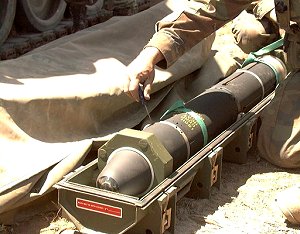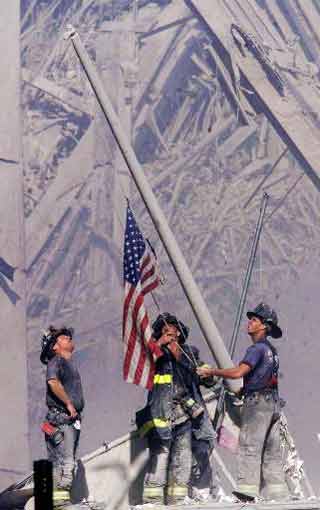|
Posted on 09/13/2004 11:37:20 PM PDT by SAMWolf
|
|
 are acknowledged, affirmed and commemorated.
|

| Our Mission: The FReeper Foxhole is dedicated to Veterans of our Nation's military forces and to others who are affected in their relationships with Veterans. In the FReeper Foxhole, Veterans or their family members should feel free to address their specific circumstances or whatever issues concern them in an atmosphere of peace, understanding, brotherhood and support. The FReeper Foxhole hopes to share with it's readers an open forum where we can learn about and discuss military history, military news and other topics of concern or interest to our readers be they Veteran's, Current Duty or anyone interested in what we have to offer. If the Foxhole makes someone appreciate, even a little, what others have sacrificed for us, then it has accomplished one of it's missions. We hope the Foxhole in some small way helps us to remember and honor those who came before us.
|

 In January 1952, a conference in Washington DC on the subject of self-propelled artillery indicated an urgent need for improved self-propelled artillery. Preliminary concept studies began for a self-propelled howitzer to replace the existing 155mm M44. The first designs in August 1952 for the new vehicle, designated the Howitzer 156mm Self-Propelled T196, were rejected, as were additional studies presented in September 1953. At a conference in May 1954, a concept was finally approved. In June 1954, a review of the military characteristics of the entire self-propelled program decided that future concepts of the T196 would be prepared along the design proposed for the Howitzer 110mm Self-Propelled T195, which was already in production. In June 1956, it was decided to use the basic hull and turret of the T195 but the original 156 mm howitzer was replaced by a 155 mm howitzer after NATO had standardized this caliber in 1956.  In October 1956, the mockup of the T196 was reviewed and verbal authority was given to proceed with development of the first prototype. The main differences from the T195 were power elevating and turret traverse mechanisms, different ammunition racks and two spades at the rear of the hull. The first prototype of the T196 was completed in 1959, about six months later than the 105 mm T195. During preliminary User Evaluation at Fort Knox a number of failures occurred in the suspension. The prototype differed from later vehicles in that it had a different shaped hull and turret, the seventh roadwheel acted as the idler and it was powered by a Continental petrol engine. In 1959 a policy was established that diesel rather than petrol engines would be used for future combat vehicles and the prototype of the T196 was then fitted with a diesel engine and redesignated the T196E1. In February 1961, an order was placed for two T196E1 preproduction vehicles which were delivered within six months. After further trials the T196E1 was classified as a Limited Production Type in December 1961.  In October 1961, a letter order was given to the Cadillac Motor Car Division for one year's production of the T196E1 at the Cleveland Army Tank Plant. The first production vehicles were completed in October 1962. In January 1963, an extension was authorised to continue the classification of Limited Production. In July 1963 the T196E1 was classified as standard A and designated the Howitzer, Medium, Self-Propelled: 155 mm, M109. Early in 1963, a contract was awarded to Cadillac for the second year of production. The contract for the third year of production, awarded in December 1963, went to the Chrysler Corporation, although production remained at the Cleveland Army Tank Plant. The first M109s were issued to the US Army in June 1963.  The 155-mm M109 series, Self-propelled medium howitzers are highly mobile combat support weapons. They are air transportable in phase III of airborne operation. They have a cruising range of 220 miles at speeds up to 35 miles per hour. Combat loaded, The M109 series weighs 27.5 tons. The 155-mm projectile weights 98 pounds. The M109 series howitzer is a vehicle that provides armored combat support, is air transportable, internally loaded, and has excellent ground mobility. It allows firing in a 360 degree circle through its primary armament, the 155mm cannon assembly, and its secondary armament, the M2 heavy barrel caliber 50 machine gun. The system is capable of both direct (line of sight) and indirect (out of the line of sight) firing.  The M109 has a crew of six, consisting of commander, gunner, three ammunition members and the driver. The hull is made of all-welded aluminium armour. The driver is at the front of the hull on the left, the engine is to his right and the turret is at the rear. The driver has a single-piece hatch cover that opens to the left, with three M45 periscopes in front that can be covered by small metal flaps to prevent damage. The commander is seated on the right side of the turret and has a cupola that can be traversed through 360°, a single-piece hatch cover that opens to the rear and an M27 periscope. Pintle mounted on the forward part of the commander's cupola is a 12.7 mm (0.50) M2 HB - also local defence machine gun. The gunner is seated on the left side of the turret and has a square single-piece hatch cover that opens to the right. The all-welded aluminium armour turret at the rear of the hull has a square hatch in each side that opens to the rear, and twin doors in the turret rear. Twin doors are provided at the rear of the turret for ammunition resupply. Mounted at the rear of the hull, each side of the hull door, is a large spade which is lowered manually to the ground before firing.  The Detroit Diesel engine is coupled to an Allison Transmission XTG-411-4A cross-drive transmission which is at the front of the hull. The torsion bar suspension consists of seven dual rubber-tyred roadwheels with the drive sprocket at the front and the idler at the rear. There are no track-return rollers. The tracks are of the single-pin, centre guide type with replaceable rubber pads. The M109 is fitted with night vision equipment but did not have an NBC system prior to the introduction of the M109A4. The basic vehicle can ford to a depth of 1.828 m without preparation. It can be fitted with an amphibious kit consisting of nine air bags, four each side of the hull and one at the front. The bags, which are not carried on the vehicle as part of its normal equipment, are inflated from the vehicle and it can then propel itself across rivers by its tracks at 6.43 km/h. In the American army, the M-109 is deployed at 54 units per armoured division and mechanized division (3 battalions of 18 vehicles equipping 3 batteries of 6 M-109). The M109 was the first model, with a very short barrel, double baffle muzzle brake, large fume extractor, and a maximum range of 14,600m. The M109A2/A3/A4 howitzers uses M185 cannon and achieves a range of 23,500 meters. The replacement of the 23 caliber long barrel with the M284 cannon 39-caliber barrel on the M109A5/A6 increased the range capability to 30,00 meters. The M109 Family of howitzer continues to improve at considerable cost savings for the customer.
|
Morning E.G.C. looks like it may be clear today.
Good morning, PE!! Thank you for the Flag-o-gram.
Army Rabble Rousers- now that's a name I really like!
The M712 Copperhead projectile was the first smart artillery round ever developed. Its accuracy is measured in centimeters, and its lethality is impressive. Copperhead is a cannon-launched, 155mm artillery projectile which guides itself to a laser-designated target. The munition is capable of defeating both armor and point targets at ranges of over six kilometers, and provides the battlefield commander with the unparalleled capability of utilizing artillery to the same effect as direct fire weapons and close air support. The system was employed during Operation Desert Storm, during which it met with great success. Copperhead projectiles were used to destroy observation and border guard posts and forward radar installations during the first week of artillery attacks.

The cannon-launched guided projectile (CLGP) M712 (Copperhead) is a 155-mm, separate-loading, laser-guided, HE projectile. It is heavier (137.6 pounds) and longer (54 inches) than the standard 155-mm projectile. The M712 projectile consists of three main sections: a guidance section (forward), warhead section (center), and control section (rear). The guidance section contains the seeker head assembly and the electronics assembly. The nose of the projectile houses a laser seeker in a plastic cone. The warhead section contains an HE antitank warhead consisting of 14.75 pounds of composition B. The control section includes the fins and wings that deploy in flight and allow the round limited maneuverability.
The trajectory of the Copperhead projectile is similar to that of a conventional round. Only when the projectile reaches a point on the descending branch of the trajectory does it differ. At that point, on the basis of the two-digit timer setting included in the fire commands, the guidance and control systems are activated. This enables the projectile to alter the remainder of its trajectory.

At 20 seconds from impact, the laser designator operator begins designating the target. The ground laser operator may use a G/VLLD, a laser target designator (LTD), or modular universal laser equipment (MULE). Airborne systems include the AH-64, OH-58D, and unmanned aerial vehicles. The Copperhead projectile acquires the reflected laser energy and initiates internal guidance and control, allowing it to maneuver to the target.
The ground surface area in which the round can maneuver is limited. The optimum limits of maneuverability of the Copperhead round is called a footprint. The size of the footprint is determined by the range and the shape of the trajectory, but it can also be affected by cloud height. The ballistic aimpoint is usually short of the target location sent by the laser designator operator. The distance that the ballistic aimpoint is short of the target location varies and is called the offset correction. This offset distance is used to ensure that the maximum probability of hit occurs at the original target location sent by the observer. The larger the target location error, the lower the probability of hitting the target.
Good Morning Mayor.

Morning Samwise.
Hi Feather. All dressed up for today. :-)
Morning PE.
Congrats to the Rabble Rousers.

Gave proof through the night,
that our Flag was still there

Yupper, I'm getting better bout remembering to get my tank out!! LOL
FAMPL ping.
Freeper Foxhole Treadhead Tuesday, a look at the M109 series SP howitzer.
At picatinney Arsenal's on post museum, there's a section dedicated to Copperhead and it's predecessor.
From what the display said, copperhead was a reworked Naval artillery shell.
The Naval variant apparently did not go forward, leaving Copperhead as the sole dog left standing.
The Naval version had the fins folding the other direction, and from what I saw, that was the only difference.
i heard from duckie & "judyjudyjudy" for the last time until Saturday next about 1030 last night. the boat was about to sail.
can you believe it costs TEN DOLLARS a MINUTE to call to/from the ship and 80 cents a minute to email????
instead of emailing me, duckie will SHOP!
LOL.
free dixie,sw
Good morning, Foxhole! Falling in right on schedule for once.
Great unit patch, by the way .. may wind up wallpaper :)
Hope you are all doing well!
The Origins of the "American Attitude"
Major George Armistead, the commanding officer at Fort McHenry requested a flag "... so large that the British will have no difficulty in seeing it from a distance..." to be flown over the Fort. (You looking for me? I'm over here!!!)
On Sept. 13, 1814, Francis Scott Key visited the British fleet in Chesapeake Bay to secure the release of Dr. William Beanes, who had been captured after the burning of Washington, D.C. The release was secured, but Key was detained on ship overnight during the shelling of Fort McHenry, one of the forts defending Baltimore. In the morning, he was so delighted to see the American flag still flying over the fort that he began a poem to commemorate the occasion.
First published under the title "Defense of Fort M'Henry," the poem soon attained wide popularity as sung to the tune "To Anacreon in Heaven." The origin of this tune is obscure, but it may have been written by John Stafford Smith, a British composer born in 1750. "The Star-Spangled Banner" was officially made the National Anthem by Congress in 1931, although it already had been adopted as such by the Army and the Navy.
Shoot and Scoot, always a good idea.:-)
Think of ALL the money she'll save you.
Do I really need a sarcasm tag?
For Dan Rather? LOL. Sorry, couldn't resist.
Thank you for your service SLB.
Good morning EGC.
Welcome to the Foxhole capocchio. Be sure and tell your brother we appreciate his service and pray he stays safe.
Disclaimer: Opinions posted on Free Republic are those of the individual posters and do not necessarily represent the opinion of Free Republic or its management. All materials posted herein are protected by copyright law and the exemption for fair use of copyrighted works.